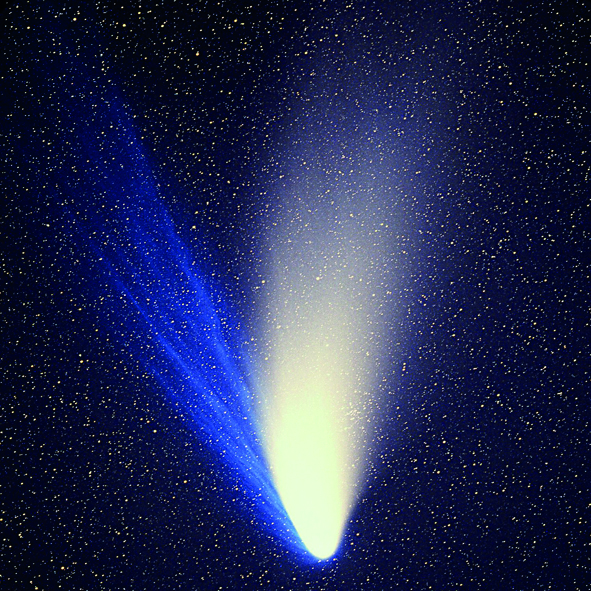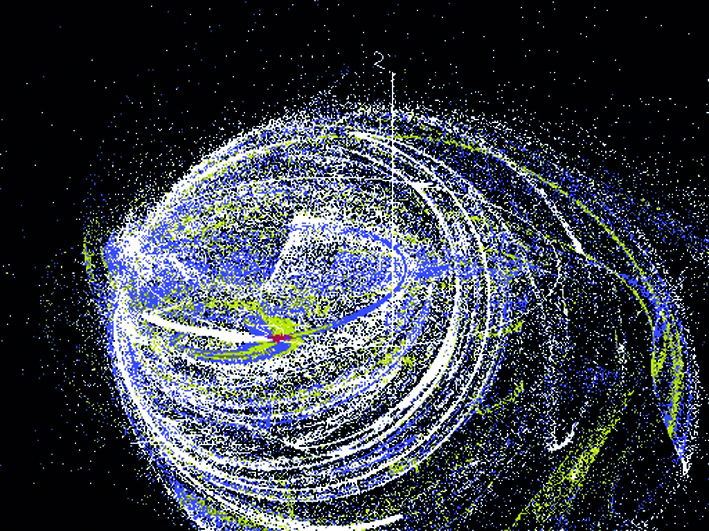What are comets made of ?

Comets are small solar system bodies which turn around the Sun on elliptical orbits.
Their nuclei are dark and elongated, and their sizes are in the range of a kilometre to several tens of kilometres.
Cometary nuclei are not very dense ; lacking significant cohesion, they are extremely fragile and can fragment or even break up completely.
Cometary nuclei are made up of ices and rocks. The ices are mostly made up of water, but they can also contain more volatile materials such as carbon monoxide, methane and ammonia. The rocks contain minerals and organic matter.
As the comets come close to the Sun, their ices sublime, which produces an atmosphere (referred to as the coma) and two main tails :
the dust tail, which is made up of dust grains swept along by the gas ;
and a plasma tail composed of ions accelerated by the solar wind.
Comets carry important information about the origin and formation of the solar system. They are in effect the remains of the small planetesimals which ultimately agglomerated into planets.
Since their birth, comets have been confined to two "reservoirs" :
- the Oort cloud, a spherical cloud at a distance of roughly 10 000 au from the Sun ;
and the Kuiper belt, a population of bodies beyond the orbit of Neptune.
Taken from the Agenda astronomique 2014, Institut de mécanique céleste et de calcul des éphémérides de l’Observatoire de Paris, EDP sciences, p. 62
The Oort cloud
In 1950, the Dutch astronomer Jan Hendrik Oort realized that the distribution of the semi-major axes of comets known at that time with periods in excess of 200 years, peaks beyond 10 000 au : to-day this peak is referred to as the Oort peak (1 au = the mean heliocentric distance of the Earth). This corresponds to a very small orbital energy.
However, as these comets enter the planetary zone of the solar system, planets modify this energy considerably, so that these comets will be ejected from the Oort peak.
From this, Oort deduced that these comets must have penetrated the planetary zone for the first time, and that therefore there must be a region, more than 10 000 au from the Sun, which contains a large number of comets.
This region, now referred to as the Oort cloud, extends out to about 200 000 au from the Sun.
The comets in this cloud become observable as a consequence of the gravitational perturbations induced by stars close to the Sun, and also by that of the entire galaxy.
Numerical simulations have shown that, to obtain the rate at which comets are observed, this cloud must contain almost 1 000 billion comets ! Such a large number is very hard to undersant in the context of theories for the formation of the Oort cloud and of the solar system.
Note that the hypothesis of the Oort cloud is based only on the distribution of the semi-major axes of long period comets ; however, no candidate member of this cloud has ever actually been observed so far.
Taken from the Agenda astronomique 2014, Institut de mécanique céleste et de calcul des éphémérides de l’Observatoire de Paris, EDP sciences, p. 150
The orbits of comets
Although planets and most asteroids move on almost circular orbits, comets, comets are different in that their orbits are much more elongated : they can be elliptical, parabolic or even hyperbolic.
Comets can be classified as a function of their orbits : there are two main classes :
- short period comets (with periods between two successive close approaches to the Sun less than 200 years) ;
- and long period comets (periods longer than 200 years). Yet another characteristic distinguishes comets from the other bodies : they are made up of rocks and ices. As they approach the Sun, the ice covering of the cometary nuclei sublimes (passes directly from the solid to the gaseeous phase, with passing through the liquid phase). This process is referred to as « cometary degassing » and leads to the creation of a reaction force which perturbs the cometary orbit.
Since these bodies sometimes come close to the Sun, their orbits will be modified slightly by the effects of general relativity.
Taken from the Agenda astronomique 2014, Institut de mécanique céleste et de calcul des éphémérides de l’Observatoire de Paris, EDP sciences, p. 164
Comets and meteorites
It is well known that, under the influence of solar radiation, comets eject gas (mainly made up of water) as well as solid particles (metéoroids).
A meteor swarm is thus created in the wake of the comet, and can extend out to many hundreds of millions of kilometres, filling up the entire orbit.
A particular feature of comets of the so-called Jupiter family is that they cross the orbit of the giant planet. During close encounters with Jupiter, the gravitational force is such that the orbit of the comet can change completely, leading to the creation of a new meteor swarm, on a new orbit.

The adjoining figure shows the position of the meteor swarm ejected by the comet Churyumov-Gerasimenko before its close encounter with Jupiter (in 1957), as it is in 2014, during the encounter of the Rosetta probe with the comet.
We note that the meteoroides are spread out over the whole solar system. The youngest meteor swarm is close to the comet, whose position is indicated by a red point. A meteor shower is produced when a planet crosses such swarm.
Taken from the Agenda astronomique 2014, Institut de mécanique céleste et de calcul des éphémérides de l’Observatoire de Paris, EDP sciences, p. 48


